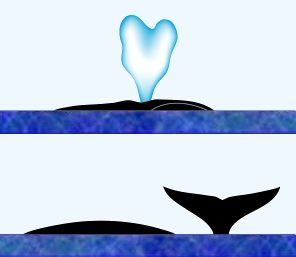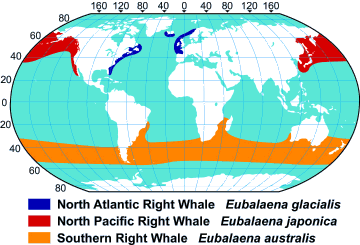KEYWORDS: right whale species right whale fact sheet Eubalaena glacialis North Atlantic right whale Eubalaena japonica North Pacific right whale Eubalaena australis southern right whale
The right whale may have received its name from whalers who thought that it was the “right” whale to kill because it was correct commercially (oil came from whales in those days), or because it was considered “proper” or “true” which meant typical of whales in general. They were easy targets, if you could ever call going out in small boats with harpoons and lances an ‘easy’ business.
Right whales swim slowly and float when dead, which was important in those days. The exploitation of the right whale began in the Bay of Biscay in Spain by the 12th century and continued, especially in the North Atlantic, for many centuries. Despite being protected since the 1930s, the right whale is today the most endangered of all the great whales.
RIGHT WHALE
Eubalaena glacialis (North Atlantic right whale), Eubalaena japonica (North Pacific right whale) Eubalaena australis (southern right whale)
 |
||
| CLASS: | Mammalia | |
| ORDER: | Cetacea | |
| SUBORDER: | Mysticeti | |
| FAMILY: | Balaenidae | |
| GENUS: | Eubalaena |
| SPECIES: | Eubalaena glacialis (North Atlantic right whale), E. japonica (North Pacific right whale), and E. australis (southern right whale) |
|
FURTHER READING: Want to read more? We recommend these books about whales, dolphins, and porpoises: Balcombe, K., and S. Minasian: 1984. The World's Whales, Smithsonian Books, W. W. Norton, New York. Killer Whales of the World: Natural History and Conservation (Worldlife Discovery Guides.) by Robin W. Baird Katona, S., V. Rough and D. Richardson. 1983. A Field Guide to the Whales, Porpoises, and Seals of the Gulf of Maine and Eastern Canada. Charles Scribner & Sons, New York. Kraus, S., and K. Mallory. 1993. The Search for the Right Whale Crown Publishers, Inc., New York. Leatherwood, S.L., and R.R. Reeves. 1976. Whales, Dolphins, and Porpoises of the Western North Atlantic: A Guide to Their Identification. U.S. Government Printing Office, Washington, D.C. Payne, R. 1976. At Home with Right Whales. National Geographic Magazine. March. Western Australian Humpback and Right Whales: An Increasing Success Story Smithsonian Handbook: Whales Dolphins and Porpoises by Mark Carwardine, Martin Camm AUDIO RECORDINGS: Whales of the World (Audio CD) Deep Voices-- Recordings of Humpback, Blue and Right Whales Sounds of the Earth: Humpback Whales VIDEOS: The Under Sea World of Jacques Cousteau - Whales The Under Sea World of Jacques Cousteau - The Singing Whale |
|
SOURCE: This fact sheed is courtesy of the AMERICAN CETACEAN SOCIETY. Fact sheets may be reprinted for educational or scientific purposes. Illustrations courtesy Uko Gorter, Copyright © 2003, All Rights Reserved. |


